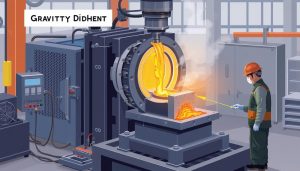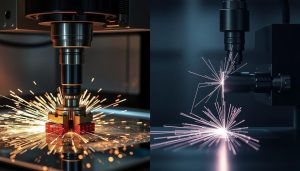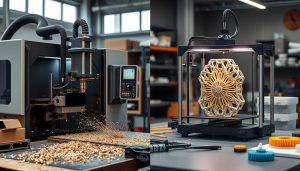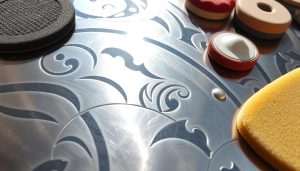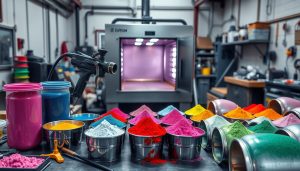In the world of semiconductor manufacturing and microelectronics fabrication, the choice between wet etching and dry etching processes can have a significant impact on the final product. This article explores the fundamental differences between these two etching techniques, examining their principles, advantages, limitations, and common applications. By understanding the unique characteristics of wet etching and dry etching, you can make an informed decision on the best approach for your specific needs.
Key Takeaways
- Wet etching and dry etching are two distinct semiconductor manufacturing processes with unique advantages and limitations.
- Wet etching uses liquid chemical solutions to remove material, while dry etching relies on energized gas-phase reactions.
- Wet etching typically offers better material compatibility and is more cost-effective, but dry etching provides superior precision and accuracy.
- The choice between wet and dry etching depends on factors such as feature size, material compatibility, and desired etching speed and efficiency.
- Understanding the differences between these techniques is crucial for optimizing microelectronics fabrication and ensuring the best results for your project.
What is Wet Etching?
Wet etching is a versatile chemical process that uses liquid etchants to selectively remove material from a substrate. This technique is widely used in the semiconductor industry, offering a cost-effective and precise way to pattern and shape various materials, including chemical etching, isotropic etching, and the application of liquid etchants.
Wet Etching Process Overview
The wet etching process typically involves immersing the substrate in a chemical solution or “etchant.” The etchant reacts with the target material, dissolving or removing it from the surface. The speed and selectivity of the etching process can be controlled by factors such as the etchant composition, temperature, and exposure time.
Advantages and Limitations of Wet Etching
- Wet etching is highly selective, allowing for precise control over the etched features.
- It is a relatively low-cost process, making it an attractive option for many applications.
- However, wet etching can also result in undercutting, where the etchant extends laterally beneath the mask, leading to a loss of feature resolution.
- The isotropic nature of wet etching can also make it challenging to achieve high-aspect-ratio structures.
Common Applications of Wet Etching
Wet etching finds numerous applications in the semiconductor industry, including the fabrication of microelectronic devices, the patterning of thin films, and the creation of microfluidic channels. It is also used in the manufacturing of MEMS (Microelectromechanical Systems) and the etching of glass, quartz, and other materials.
| Application | Material | Etchant |
|---|---|---|
| Semiconductor device fabrication | Silicon, silicon dioxide, metals | Hydrofluoric acid, nitric acid, acetic acid |
| Thin film patterning | Metals, dielectrics | Phosphoric acid, sulfuric acid, hydrochloric acid |
| Microfluidic channel formation | Glass, quartz, polymers | Hydrofluoric acid, potassium hydroxide |
What is Dry Etching?
Dry etching is a crucial process in the world of advanced semiconductor manufacturing. Unlike wet etching, which uses liquid chemicals, dry etching employs plasma or ion beams to remove material from a substrate. This innovative technique offers a range of advantages and is widely used in various applications.
Dry Etching Process Overview
The dry etching process typically involves the use of plasma etching or reactive ion etching (RIE). In plasma etching, the substrate is placed in a vacuum chamber and exposed to a high-energy plasma, which selectively removes material from the surface. Reactive ion etching, on the other hand, utilizes a combination of chemical reactions and physical bombardment to achieve a highly anisotropic etch profile.
Advantages and Limitations of Dry Etching
- High anisotropy: Dry etching techniques, such as anisotropic etching, can produce precise, vertical sidewall profiles, making them ideal for intricate device fabrication.
- Excellent precision and control: The ability to fine-tune the etching parameters allows for exceptional control over the etching process and the final feature dimensions.
- Versatility: Dry etching can be used on a wide range of materials, from metals and semiconductors to ceramics and polymers.
- Limitations: Dry etching systems can be more complex and require specialized equipment, and the process can be more energy-intensive compared to wet etching.
Common Applications of Dry Etching
Dry etching techniques find widespread use in the semiconductor industry, particularly in the fabrication of microprocessors, memory devices, and various integrated circuits. Plasma etching and reactive ion etching are commonly employed for pattern transfer, material removal, and surface cleaning in advanced device manufacturing.
| Dry Etching Technique | Key Applications |
|---|---|
| Plasma Etching | Etching of silicon, polysilicon, and metal layers in integrated circuits |
| Reactive Ion Etching (RIE) | Patterning of microelectronic devices, such as transistors and memory cells |
| Anisotropic Etching | Fabrication of high-aspect-ratio structures, including MEMS devices and nanostructures |

“Dry etching techniques have revolutionized the semiconductor industry, enabling the fabrication of increasingly complex and miniaturized devices.”
Wet Etching vs Dry Etching: A Detailed Comparison
As the semiconductor industry continues to evolve, the choice between wet etching and dry etching has become a critical decision for manufacturers. These two techniques offer distinct advantages and limitations, each with its own impact on precision, accuracy, material compatibility, and efficiency.
Precision and Accuracy
Wet etching is known for its ability to achieve higher etch rates and better selectivity, making it a preferred choice for features with larger aspect ratios and feature sizes. However, the isotropic nature of wet etching can lead to undercut and reduced control over feature profiles. Conversely, dry etching, particularly plasma-based techniques, offers superior anisotropy, enabling the fabrication of high-aspect ratio structures with exceptional feature size control.
Material Compatibility
The compatibility of wet and dry etching methods with various materials is a crucial consideration. Wet etching excels in etching silicon-based materials, metals, and certain dielectrics, while dry etching is more versatile, accommodating a broader range of materials, including challenging compounds and high-aspect ratio structures.
Speed and Efficiency
When it comes to throughput and efficiency, dry etching typically outperforms wet etching. Dry etching processes are often faster, with higher etch rates, and can be more easily integrated into automated manufacturing lines. However, wet etching can offer cost-effective solutions for specific applications, particularly in the production of simple, large-scale features.
| Comparison Factor | Wet Etching | Dry Etching |
|---|---|---|
| Precision and Accuracy | Higher etch rates, better selectivity, suitable for larger feature sizes and aspect ratios | Superior anisotropy, better feature size control, enabling high-aspect ratio structures |
| Material Compatibility | Excels in etching silicon-based materials, metals, and certain dielectrics | More versatile, accommodates a broader range of materials, including challenging compounds and high-aspect ratio structures |
| Speed and Efficiency | Can be cost-effective for simple, large-scale features | Typically faster, with higher etch rates, and more easily integrated into automated manufacturing lines |
“The choice between wet etching and dry etching is not a one-size-fits-all decision. It requires a careful consideration of the specific requirements of the manufacturing process and the desired outcomes.”
Choosing the Right Etching Method for Your Needs
When it comes to MEMS fabrication, integrated circuit manufacturing, and photonics, the choice between wet etching and dry etching can significantly impact the outcome of your project. Each method has its own unique advantages and limitations, so it’s crucial to consider the specific factors that will guide your decision.
Factors to Consider When Deciding Between Wet and Dry Etching
The key factors to weigh when selecting an etching method include:
- Desired feature size: Dry etching generally offers better precision and resolution, making it more suitable for smaller, more intricate features.
- Material compatibility: Wet etching is better suited for certain materials, such as silicon, while dry etching can handle a wider range of materials, including metals and ceramics.
- Production volume: Dry etching is typically faster and more efficient for higher-volume production, while wet etching may be more cost-effective for smaller batches.
Industry-Specific Considerations
When selecting an etching method for your MEMS fabrication, integrated circuit manufacturing, or photonics project, it’s also important to consider industry-specific factors:
- MEMS fabrication: Dry etching is often preferred for MEMS devices due to its ability to create high-aspect-ratio structures and its compatibility with a wider range of materials.
- Integrated circuit manufacturing: Both wet and dry etching are used in integrated circuit manufacturing, with dry etching typically used for smaller feature sizes and better control over the etching process.
- Photonics: Dry etching is commonly used in photonics applications, as it allows for the creation of precise, high-quality optical components and structures.
By carefully weighing these factors and considering the specific needs of your industry, you can make an informed decision about the most suitable etching method for your project.

Why Choose Shixinproto for Etching Services
When it comes to professional etching services, Shixinproto stands out as a trusted partner. With their advanced technology and customized solutions, the company has established itself as a leader in both wet and dry etching processes. Shixinproto’s experienced team of experts is dedicated to delivering exceptional results that meet the unique requirements of clients across various industries.
At Shixinproto, the focus is on providing tailored solutions that optimize the etching process for each client’s specific needs. Whether you require precision and accuracy in your etching or need to accommodate a wide range of materials, Shixinproto has the expertise to ensure your project’s success. Their state-of-the-art facilities and cutting-edge equipment enable them to deliver efficient and reliable etching services, ensuring your satisfaction every step of the way.
Shixinproto’s commitment to quality and innovation is evident in their dedication to staying at the forefront of the industry. By continuously investing in advanced technology and refining their processes, the company ensures that their clients receive the best possible outcomes. When you choose Shixinproto, you can trust that your etching needs will be handled with the utmost care and professionalism, giving you the confidence to move your project forward with ease.
